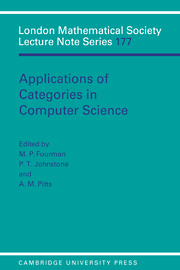 Applications of Categories in Computer Science
Applications of Categories in Computer Science Published online by Cambridge University Press: 24 September 2009
The first aim of this paper is to attack a problem posed in [1] about uniform families of maps between realizable functors on PER's.
To put this into context, suppose that we are given a category C to serve as our category of types. The authors of [1] observe that the types representable in the second-order lambda; calculus and most extensions thereof can be regarded as being obtained from functors (Cop × C)n → C by diagonalisation of corresponding contra and covariant arguments. Terms in the calculus give rise to dinatural transformations. This suggests a general structure in which parametrised types are interpreted by arbitrary functors (Cop × C)n → C, and their elements by dinatural transformations. Unfortunately as the authors of the original paper point out, this interpretation can not be carried out in general since dinaturals do not necessarily compose.
However, suppose we are in the extraordinary position that all families of maps which are of the correct form to be a dinatural transformation between functors (Cop × C)n → C are in fact dinatural, a situation in which we have, so to speak, the dinaturality for free. In this situation dinaturals compose. The result is a structure for a system in which types can be parametrised by types (second-order lambda calculus without the polymorphic types). Suppose, in addition, the category in question is complete, then we can perform the necessary quantification (which is in fact a simple product), and obtain a model for the second-order lambda calculus.
To save this book to your Kindle, first ensure [email protected] is added to your Approved Personal Document E-mail List under your Personal Document Settings on the Manage Your Content and Devices page of your Amazon account. Then enter the ‘name’ part of your Kindle email address below. Find out more about saving to your Kindle.
Note you can select to save to either the @free.kindle.com or @kindle.com variations. ‘@free.kindle.com’ emails are free but can only be saved to your device when it is connected to wi-fi. ‘@kindle.com’ emails can be delivered even when you are not connected to wi-fi, but note that service fees apply.
Find out more about the Kindle Personal Document Service.
To save content items to your account, please confirm that you agree to abide by our usage policies. If this is the first time you use this feature, you will be asked to authorise Cambridge Core to connect with your account. Find out more about saving content to Dropbox.
To save content items to your account, please confirm that you agree to abide by our usage policies. If this is the first time you use this feature, you will be asked to authorise Cambridge Core to connect with your account. Find out more about saving content to Google Drive.